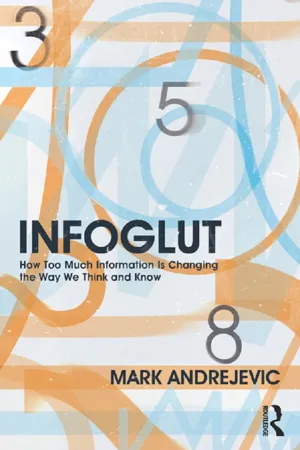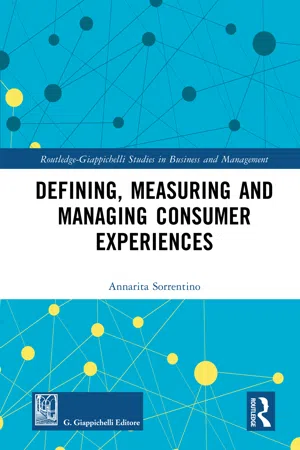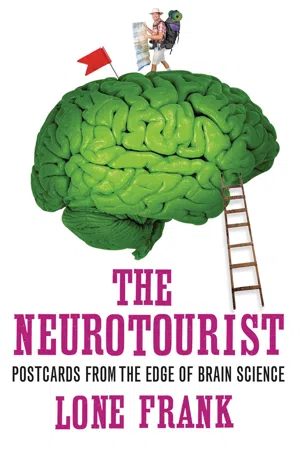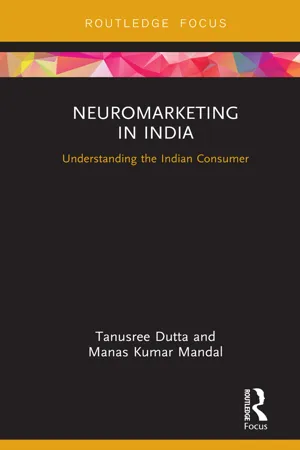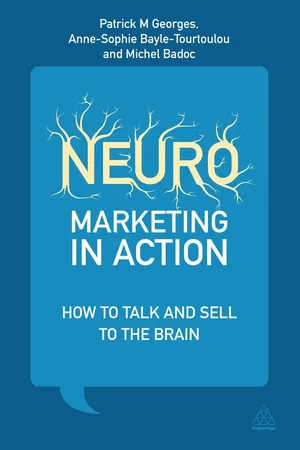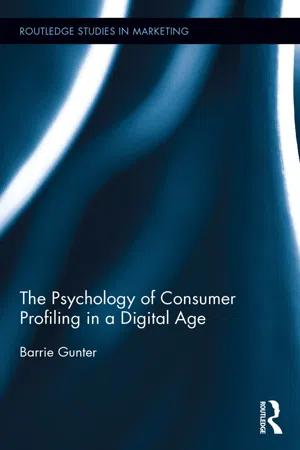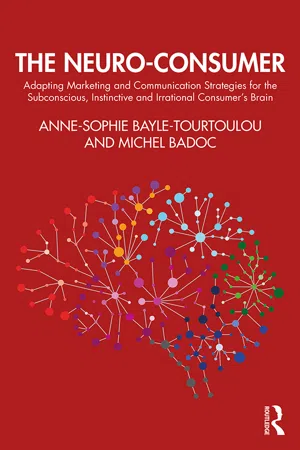Marketing
Neuromarketing
Neuromarketing is a field that applies neuroscience techniques to understand and influence consumer behavior. By using tools such as brain imaging and biometric measurements, neuromarketers can gain insights into consumers' subconscious responses to marketing stimuli. This allows them to create more effective marketing strategies and campaigns that resonate with consumers on a deeper level.
Written by Perlego with AI-assistance
Related key terms
1 of 5
12 Key excerpts on "Neuromarketing"
- eBook - ePub
Marketing Analytics
A Machine Learning Approach
- A. Mansurali, P. Mary Jeyanthi, A. Mansurali, P. Mary Jeyanthi(Authors)
- 2023(Publication Date)
- Apple Academic Press(Publisher)
Gazzaniga, Ivry, and Mangun, 2002 ), Neuromarketing seeks to implement and evaluate marketing plans, prospects, actions, and strategic moves of the companies.Literature including Fugate (2007 ); Renvoise and Morin (2007 ); and Zurawicki (2010 ) considered Neuromarketing as a marketing research tool that uses ‘science’ to locate consumers’ ‘buy button’ so as to open the ‘black box’ of consumers’ mind. Vecchiato, Cherubino, Trettel, and Babiloni (2013) viewed Neuromarketing as a field of market that applies the tools and techniques of neuroscience such as fMRI, EEG, and facial coding to understand the mysteries of ‘buy button’ in consumers’ brain and to study consumer behavior related economic exchanges. According to this view, the contribution of the neuroscientific method becomes more significant for the knowledge and analysis of human behavior in the marketing landscape (Sung, Wilson, Yun, and Lee, 2019). It is based on the notion that the brain imaging technique is very helpful for distinguishing the cognitive experiences and responses that are, in most cases, verbally the prospective customers during interviews with them.Neuromarketing is developed on the basis of two assumptions; one is that a consumer’s sensory and motor systems are represented in the networks of the brain, and hence they can be identified by studying the networks of the brain. Secondly, consumer decision making, more specifically the mysteries of ‘buy button’ in their brain can be identified by observing the networks of the brain. The mysteries of buy-button and the secrets behind why consumers behave the way they do cannot be revealed by conventional marketing research methods, such as interviews, surveys, field studies, reviews, and so on (Mileti, Guido, and Prete, 2016 ). Traditional marketing research uses techniques such as surveys, focus groups, interviews, experiments, etc., in order to seek information and insights about customers’ preferences, behavior, and decision making. However, Neuromarketing provides more accurate predictions of consumer preferences and behavior since it uses neuroscientific measures such as eye-tracking, facial coding, galvanic skin responses, electroencephalography (EEG) and fMRI. Out of these techniques, fMRI is the most widely used technique of Neuromarketing. fMRI helps market researchers scan and detect the changes in the blood flow in the brain of consumers due to any external stimuli, which in this case is the marketing stimulus such as advertising (Madan and Popli, 2016 - eBook - ePub
Contemporary Issues in Marketing
Principles and Practice
- Ayantunji Gbadamosi(Author)
- 2019(Publication Date)
- SAGE Publications Ltd(Publisher)
Recognising the needs of customers is the main concern of all organisations, since the basis of staying competitive lies in the capability to assess and develop products and services that can satisfy customers better than competitors. Traditional marketing methods and persuasion techniques (especially in light of technological advancements and digital marketing methods) have forced many organisations to reevaluate their ability to reach consumers. Many researchers argue that the methods of ‘articulated answers’ (Burgos-Campero and Vargas-Hernandez, 2013), such as market research, surveys and focus groups, are not enough to understand the way individuals feel about a product or service because it is difficult to describe exactly the emotions experienced by a person in response to a stimulus such as a product. They also question the validity of traditional methods in their analysis of consumer behaviour. For example, in the case of focus groups, participants’ responses may be affected by the majority, in addition to being influenced by other factors such as incentives, time and pressure that may prejudice the final results. Surveys, in turn, require large samples and intricate design tools to be able to deal with variables that affect reliability such as language, education and cultural or subcultural variations.Reconsidering traditional marketing methods, among other reasons, paved the way for the emergence of Neuromarketing. Neuromarketing is the subfield of neuroscience research that attempts to better understand the consumer through his or her unconscious processes, explaining consumers’ preferences, motivations and expectations, predicting behaviour and evaluating the needs and orientations of advertising messages (Fisher et al., 2010; Gatterer, 2012). Neuromarketing is an emerging interdisciplinary field that aims to investigate and understand consumer behaviour by studying the functions of the human brain. Neuroscience attempts to gather information on the structure and functions of the human brain and its sub-domain called ‘cognitive neuroscience’ (Javor et al., 2013). It seeks to understand the neural mechanisms behind thoughts, reasoning, emotions, memory or decision making. One of the major techniques to measure marketing stimuli is neuroimaging. When used in marketing to comprehend consumer behaviour, these methods are called Neuromarketing techniques. Thus, by using neuroimaging techniques, researchers can measure subjects’ responses to marketing stimuli. Therefore, the development of this field depends on the advance of science, technology, computer science and neuroscience. The aim of Neuromarketing is to study the physiological response of the brain to advertising and marketing strategies. In order to evaluate the effectiveness of these strategies, the resulting brain activity from this phenomenon is monitored and measured using neuroimaging techniques. Neuroscientists are now able to directly study the frequency, location and timing of neuronal activity in an exceptional way (Lee et al., 2007). - eBook - ePub
Infoglut
How Too Much Information Is Changing the Way We Think and Know
- Mark Andrejevic(Author)
- 2013(Publication Date)
- Routledge(Publisher)
22 As we shall see, the promise of Neuromarketing is tailored, in a sense, to a context characterized by a knowing skepticism toward expertise – one in which the grounds for “expert advice” are called into question in the name of a reactionary populism. First, however, it is worth exploring in a bit more detail the promise of Neuromarketing.Brain Whispering and Somatic Markers
In the simplest terms, Neuromarketing is the application of recent developments in brain research to marketing. As one marketer puts it, Neuromarketing refers to “studying the brain to help advertisers tap into people’s unarticulated [responses] needs, drives and desires.”23 Companies including Google, Intel, DaimlerChrysler, and Microsoft have all incorporated Neuromarketing into their market research strategies, at least on a trial basis, and the AC Nielsen company, internationally known for its media ratings services, recently acquired Berkeley-based NeuroFocus to supplement its market research offerings, literally buying into the claim that “Great advertising strikes a responsive chord with consumers where it matters most: the subconscious. Only neurological testing can make the ‘deep dive’ required to access that level of the brain and discover how it responds to all forms of advertising, in every medium.”24From a somewhat different perspective, we might describe Neuromarketing as a particular way of thinking about individuals as what Fernando Vidal calls “cerebral subjects”– entities whose very essence as subjects is defined by their brain. As Vidal puts it, “the neuroscientific hype highlights the ascendancy, throughout industrialized and highly medicalized societies, of a certain view of the human being … As a ‘cerebral subject’, the human being is specified by the property of ‘brainhood,’ i.e. the property or quality of being , rather than simply having , a brain.”25 It is easy to trace this understanding of the subject in Neuromarketing discourses, which invoke the brain metonymically to refer to consumers of all kinds. NeuroFocus’s promotional literature, for example, observes that “Great entertainment engages and delights the brain with content that is new, exciting, relevant, and memorable. Neurological testing allows producers to develop material the brain loves and remembers.”26 - Annarita Sorrentino(Author)
- 2020(Publication Date)
- Routledge(Publisher)
Neuromarketing TO DISCOVER THE SMALL INSIGHTSSUMMARY : 3.1. Marketing and neuroscience. – 3.2. Consumer neuroscience and consumer theory. – 3.3. Applications of consumer neuroscience. – 3.4. Neuro-marketing and branding. – 3.5. Research in consumer neuroscience. – 3.6. Most common methods and devices used during a typical Neuromarketing experiment. – 3.6.1. Biometric indicators. – 3.7. How neuroscience can help marketing research.3.1. Marketing and neuroscienceIn the last few years we have assisted to an increased interest in the use of brain imaging techniques for the analysis of brain responses to the commercial advertisements or for the investigation of the consumers’ purchasing attitudes (Ambler et al., 2000; Knutson et al., 2007; Astolfi et al., 2009; Vecchiato et al., 2014). This interest is justified by the possibility to correlate particular observed brain activations with the characteristics of a proposed commercial stimulus, in order to derive conclusions about the adequacy of such marketing stimulus (advertising, packaging etc.) to be interesting or emotionally engaging.Many standard marketing techniques employed so far involved, instead, the use of interviews and the compilation of a questionnaire after the exposition to a commercial advertising, products and services before their massive launch – in a pre-test phase (Cherubino et al., 2016). However, it is now recognized that, often, the verbal advertising pre-testing is flawed by the respondents’ cognitive processes activated during the interview, being the implicit memory and subject’s feelings often inaccessible to the interviewer that uses traditional techniques (Zaltman, 2003). Very frequently, consumers are not able to rationally justify their own purchasing behaviour, which often greatly differs from their original intent, in favour of a “last-minute decision” taken in-store and based on their instinctive reasons. Such nature of the “decision-making” process, which seems out of control during the conscious rational choice of goods or services, can be explained by the different emotional systems present in the human brain, that can easily access the centers of decisional behaviour without being subjected to the filter of the brain’s cognitive part.- eBook - ePub
The Neurotourist
Postcards from the Edge of Brain Science
- Lone Frank(Author)
- 2011(Publication Date)
- Oneworld Publications(Publisher)
7SELLING IT TO YOUR NEURONS
Say the word: Neuromarketing . Doesn’t exactly sound good, does it? It’s an outlandish word that scrapes across the tongue, leaving an aftertaste of thought control, science fiction, and downright creepiness. The press surrounding Neuromarketing reflects this as well. The headlines are ominous: soon, the bright boys of the advertising world will get their sticky hands on our inner “buy button.” Soon, marketing experts, with the help of cutting-edge brain research, will get direct access to the inner depths of our brains where, with the right stimulation, they can unleash our buying impulses and get their cash registers ringing.Neuromarketing is a young and growing field – some won’t even admit that it is a field yet – that is striving to reveal the inner mechanisms of our consumer behavior. You might say that this interest and the issues it raises are a natural extension or offshoot of neuroeconomics and the more general studies of how we make choices and decisions. Every so often, there is also a conspicuous overlap between neuroeconomists and researchers in Neuromarketing. The studies in Neuromarketing are just more specific and much more directed. And the Holy Grail lies in predicting what the brain wants.In the advertising industry, you can see Neuromarketing as an attempt to make the “art” of advertising into a science Any marketing expert proposing a multi-million dollar project to a client would like to be able to back it up with something that looks like real data, not just hunches. To answer this need, marketing has already drawn on psychology in developing tests and theories, and ad people have borrowed the idea of the focus group from social scientists. Brain research is the third wave. And Neuromarketing has taken on a warm, fuzzy glow in the advertising world, where they convene meetings and conferences about its potential and, every so often, proclaim in their journals that it is the undeniable wave of the future. Such enthusiasm is harder to find in the scientific arena. Marketing is not - eBook - ePub
Neuromarketing in India
Understanding the Indian Consumer
- Tanusree Dutta, Manas Kumar Mandal(Authors)
- 2018(Publication Date)
- Taylor & Francis(Publisher)
Neuromarketing An emerging interdisciplinary scienceIn the longer run and for wide-reaching issues, more creative solutions tend to come from imaginative interdisciplinary collaboration. – Robert J. ShillerScientific discourse on Neuromarketing to develop a biological model to explain context-based human behaviour has often been neglected. Behaviour is an outcome of intent, and intent is shaped by various factors. The field of Neuromarketing is an interdisciplinary field. The term ‘Neuromarketing’ is coined from two words, namely, neuroscience and marketing. But it draws heavily from research done in the fields of psychology, marketing and neuroscience. Valuable advances in the field of neuroscience in the last few years have brought us very close to developing an understanding of how the consumer’s mind works. In this chapter, an attempt is made to elaborate on how different disciplines have contributed towards the growth of this discipline.Research done in a number of allied fields has contributed in developing an understanding of human behaviour. Studies conducted on human attention have helped the field of advertisement to develop advertisements that are eye catching and retain human attention; studies in memory have contributed a lot in developing strategies for product recall and branding. Research directed towards developing a critical understanding about decision-making has helped in effective negotiation. Principally, Neuromarketing has benefitted a lot from cognitive neuroscience—which helps in developing an objective understanding of an individual’s thought processes; affective neuroscience helps in developing an understanding about the neural mechanism of emotional behaviour and behavioural neuroscience helps to develop a keen understanding of the various factors that interplay to generate human behaviour. These three areas interact in the generation of observable behaviour. However, the contributions from other fields such as neuropsychology—that explores brain-behaviour relationship, experimental psychology—on which the field of Neuromarketing relies heavily for methodological concerns, consumer neuroscience—which helps to investigate consumer centric problems, decision neuroscience—which helps to delve deeper into how decisions are made, cannot be neglected. Next we present a brief summary of the various studies that have been conducted in different disciplines that have contributed towards the field of Neuromarketing. We have concentrated on some of the major disciplines. There may be other disciplines as well which have contributed in some way to make Neuromarketing more relevant. - eBook - ePub
Neuromarketing in Action
How to Talk and Sell to the Brain
- Patrick M Georges, Anne-Sophie Bayle-Tourtoulou, Michel Badoc(Authors)
- 2013(Publication Date)
- Kogan Page(Publisher)
PART I Neuromarketing or the art of selling to the brain A s a science studying how to bring companies closer to their customers, marketing has numerous limitations in terms of studies as well as business approach, sales and communication. By drawing on neuroscience, which helps probe human intelligence and comprehends the unconscious of the brain, it significantly improves its efficacy with all its interlocutors: managers, employees, partners and, of course, customers. This new approach constitutes the Neuromarketing domain. It was born out of the technical possibilities, inspired by the medical sector, of analysing how the brain works and their applications to marketing. Studies in neuromedicine largely rely on the possibility of lighting up the lobes of the brain associated with decision making and action. They were identified by a wealth of medical research relating to epilepsy, Parkinson’s disease and other forms of brain injury. Studies also draw on the analysis of hormone secretion and its impact on human behaviour. For instance when dopamine is largely secreted, it provides pleasure and makes the desire to buy products greater. Neuromarketing studies help in understanding how the brain responds to different stimuli and making decisions. The use of neuroscience in the marketing approach, because of its efficiency, is not without danger. It can be used properly only by marketers with sound ethics and irreproachable professional conduct. 01 Marketing and its limitations in understanding human intelligence M arketing represents an analytical tool, a state of mind, an approach, and technical expertise. As with a sporting event that one watches while comfortably seated in the stadium or in front of the television, its practice may, at first glance, seem simple, if not simplistic. This is a misleading illusion. Success is the result of patented professionalism as well as serious predispositions - eBook - ePub
Innovation and Capacity Building
Cross-disciplinary Management Theories for Practical Applications
- Demetris Vrontis, Yaakov Weber, Alkis Thrassou, S. M. Riad Shams, Evangelos Tsoukatos, Demetris Vrontis, Yaakov Weber, Alkis Thrassou, S. M. Riad Shams, Evangelos Tsoukatos(Authors)
- 2018(Publication Date)
- Palgrave Macmillan(Publisher)
Its goal is to enhance marketing theory and practice (Plassmann et al. 2015 ; Yoon et al. 2012) or to improve the accuracy of predictions of consumer preferences and behaviour when combined with traditional techniques (Boksem and Smidts 2015 ; Smidts et al. 2014 ; Venkatraman et al. 2015 ; O’Doherty et al., 2008). Researchers use technologies such as functional magnetic resonance imaging (fMRI) and electroencephalography (EEG) to measure specific types of brain activity in response to advertising messages. With this information, companies learn why consumers make the decisions they do and what parts of the brain motivate them to do so (Ghorpade 2017). According to Nick Lee, Honorary Professor of Marketing and Organizational Research, Aston University, “Executives love the idea of using brain scans. As brain imaging and neuroscience develop, Neuromarketing companies will be able to pull out more sophisticated data about what makes people want to buy or avoid certain items. The big question is whether Neuromarketing can push a ‘buy-button’ in your brain.” (Nyoni and Bonga, 2017b). The major gap we can find here is the scarce application of Neuromarketing techniques (Feenstra and Pallarés-Domínguez 2017). While some sceptics and detractors describe Neuromarketing as a sort of “brain washing” (Ghorpade 2017), its techniques could allow us to form a reliable view of how companies deal with ethical issues (Feenstra and Pallarés-Domínguez 2017). Threats to consumer autonomy, privacy and control are not meaningful ethical issues given the current capabilities and implementation of Neuromarketing research (Stanton et al. 2017). Neuromarketing has clear potential for making a positive impact on society and consumers, a fact rarely considered in the discussion on the ethics of Neuromarketing (Stanton et al. 2017) by firms, which prefers to limit or completely avoid this powerful instrument of monitoring - eBook - ePub
Innovative Research Methodologies in Management
Volume II: Futures, Biometrics and Neuroscience Research
- Luiz Moutinho, Mladen Sokele, Luiz Moutinho, Mladen Sokele(Authors)
- 2017(Publication Date)
- Palgrave Macmillan(Publisher)
decision neuroscience .We will use consumer neuroscience and Neuromarketing interchangeably (e.g., Lee et al. 2007 ; Morin 2011 ; Reimann et al. 2011 ) for a few reasons . First, Neuromarketing is more familiar to most readers. A distinction seems to confuse them without adding much value. Second, it is sometimes easier defining such a distinction than actually making one. For example, Dietvorst et al. (2009 ) developed a sales force-specific Theory-of-Mind (ToM) scale and validated the questionnaire -based scale with neuroimaging data. The authors found that those who scored high in the scale showed more activation in brain areas that are associated with ToM or mentalization in interpersonal situations than those who scored low in the scale. While the development of the scale is guided by consumer theory, the scale itself has great potential for commercial use. It is not clear to us whether this advancement should be classified as consumer neuroscience or Neuromarketing.Another debate is whether Neuromarketing should be treated as a branch of neuroscience studying human behavior by borrowing the theoretical perspectives from consumer research, or if it is more accurately a part of consumer research trying to contribute to the development of consumer theories by utilizing neuroscientific method ologies (Plassmann et al. 2015 ). While the former may contribute to the study of science generally, or neuroscience more specifically, the focus of this chapter is on the latter, as this book is written for readers who are interested in recent advancements in research in management. In order to contribute to consumer research, Chen et al. (2015 ) proposed that Neuromarketing researchers should move on from answering the “where”-type questions to the “what”-type questions. The former refers to the stage when research focuses on physically localizing different psychological processes. Shifting the focus involves answering questions such as what process is involved, and what and how information is being processed. More specifically, Shiv et al. (2005 ) proposed a few ways that neuroscientific methods might contribute to consumer research by:- 1. providing confirmatory evidence about the existence of a phenomenon,
- 2. generating a more fundamental (i.e., a neural level) conceptualization and understanding of underlying processes,
- 3. refining existing conceptualizations of various phenomena, and
- 4. providing methodologies for testing new as well as existing theories.
- Barrie Gunter(Author)
- 2016(Publication Date)
- Routledge(Publisher)
There are ethical questions about the use of cognitive neuroscience in marketing research settings. Codes of professional research practice generally require that participants in social research are able to provide informed consent before they take part. This means they must understand what they are being required to do and what kinds of data are being collected about them. Although it should generally be possible to provide this information, the fact that non-conscious reactions of consumers are being measured to specific stimuli could equip commercial marketers with data that would enable them to use marketing techniques that are designed to re-activate those neurological responses without consumers’ awareness (Lovell, 2008). It will be important, therefore, that participants in experiments understand the full implications of the research being carried out before they decide to cooperate (Fleming, 2006; Kenning et al., 2007; Ariely & Bems, 2010).The ethical cause of Neuromarketing has not been helped by problematic journalistic coverage that has classed this new approach to marketing as a mysterious science designed to help marketers deceive consumers. Reports about neuroscience developments in the marketing context have been linked to subliminal advertising whereby marketers learn how to influence consumers’ brains without their conscious awareness and in turn manipulate their buying behaviours (Pratkanis & Greenwald, 1988; Fullerton, 2010). What has also not helped with the establishment of neuroscience as a respectable discipline when used in the marketing sphere is the enthusiasm with which it has been adopted by commercial market research agencies. It was therefore labelled as a commercial service driven by financial imperatives rather than a genuine desire to discover new knowledge about consumer behaviour (Lee, Broderick & Chamberlain, 2007).It will be important for the value of Neuromarketing to be underpinned by establishing its credibility and trustworthiness through references to neuroscience conducted under commercially independent scientific conditions in which the primary goal is to understand how the brain works in different behavioural settings (Javor, Koller, Lee, Chamberlain & Ransmayr, 2013). Much neuroscience has targeted our understanding of reward systems within the brain that become activated when we are confronted with pleasurable stimuli, regardless of the social context. Where these emotional reactions attach to specific commodities and they can be identified through patterns of brain activity, there are opportunities to develop a deeper understanding of the choices consumers make (Miller & Cohen, 2001).- eBook - ePub
The Neuro-Consumer
Adapting Marketing and Communication Strategies for the Subconscious, Instinctive and Irrational Consumer's Brain
- Anne-Sophie Bayle-Tourtoulou, Michel Badoc(Authors)
- 2020(Publication Date)
- Routledge(Publisher)
- The first applications in marketing began in the 2000s. The American researcher Read Montague and his colleagues had the idea of using MRI in an experiment relating to the Coca-Cola and Pepsi brands.
- The term “Neuromarketing” is often attributed to Montague. Experiments aimed at better understanding consumer behavior by applying neuroscientific techniques have become increasingly frequent throughout the world. Numerous specialized companies have come into being in recent years: SalesBrain, NeuroSense, NeuroFocus, etc. and experimentation has developed in the research centers of major universities. Various books describe their applications. The majority of major international companies use Neuromarketing to make their marketing and communication more effective.
- Several observation-based approaches have led to the development of techniques such as NLP and TA, etc. Neuroscientific techniques allow researchers to go deeper into the understanding of the neuro-consumer’s behavior and range from the more complex, such as MRI and EEG, to cheaper, simpler tools, including hormonal secretion, EDA, ECG, eye tracking and simple neuroscientific diagnosis. Some of these techniques are coupled with other neuroscientific tools or with traditional marketing and communication studies. Their objective is not to call existing research into question, but to improve on it and complement it.
- eBook - PDF
Histories of Human Engineering
Tact and Technology
- Maarten Derksen(Author)
- 2017(Publication Date)
- Cambridge University Press(Publisher)
1 Introduction A Revolution in Marketing A revolution has been proclaimed in the field of marketing: the age of Neuromarketing is dawning. Now that researchers can look directly into the brain with an fMRI scanner, they can see what really attracts people in an advertisement or television commercial and what moves them to buy a product. Neuromarketing research has found our ‘buy button’, and if you have something to sell, it can tell you exactly how to push that button. How it works is described in a book aimed at business owners, salespeople and marketers titled The Buy Button. 1 It was written by Martin de Munnik, one of the people behind Neurensics, an Amsterdam research and consulting firm that specialises in Neuromarketing. In The Buy Button, subtitled The Secret of the Consumer’s Brain, De Munnik tells us of the groundbreaking discovery that the decision to buy a product is the result of the interplay between three brain areas: the nucleus accumbens, the insula and the medial prefrontal cortex. These three areas together are the buy button, ‘the greatest Neuromarketing revelation of all time’, as the book’s cover proclaims. Companies like Neurensics have taken this scien- tific discovery and turned it into practical applications. With an fMRI scanner they can look into the brain and see the activity in these areas when subjects are presented with, for example, different advertisements for breakfast cereal or nail polish. Choosing the best advertisement, once an art based on gut feelings, has become a science. Marketing has been transformed into a ‘lottery without blanks’. 2 That, at least, is the claim. Let us for the moment put aside the question of whether there really is a buy button in the brain – suffice it to say that there are other neuro- marketing researchers who call the idea ‘bullshit’ and warn of ‘neuro- cowboys’ harming the field by overselling it.
Index pages curate the most relevant extracts from our library of academic textbooks. They’ve been created using an in-house natural language model (NLM), each adding context and meaning to key research topics.


